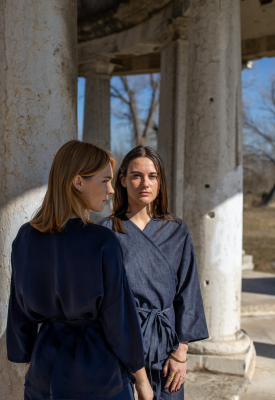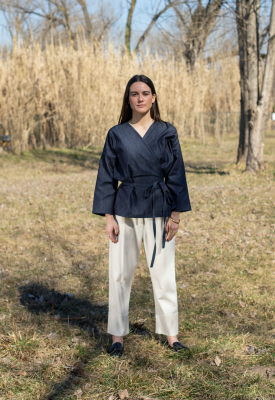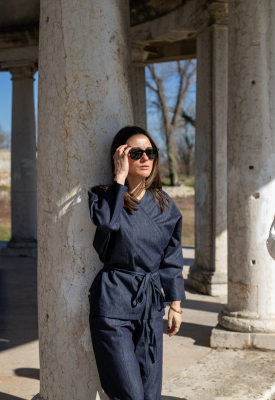What was your first project?
Probably the degree thesis was my first real project. The first in which I discover the sustainability issue as a fundamental value. I wanted the materials to give me ideas, shapes, designs, and not vice-versa. Follow an inspiration and then find fabrics that could create it. It seemed like the best way not to have to compromise between aesthetics and sustainability. With Filotimo I try to follow this project process.
Creative process: do you work instinctively or planning each single small step? Where do your ideas come from?
I’m not a methodical person, unfortunately. In some cases, it would help me a lot, but I also realized that if I overplan things, I end up feeling stuck in my ideas in my ideas. The first part of my creative process is very instinctive. Then some things work immediately, and they come to life with a surprising naturalness, others not. The way I am, I’d be tempted to abandon them and think about something else. However, over the years, I have understood that having a bit of constancy, in these cases, serves not to give up projects with great potential that only need some fixing. Concerning ideas, very often they come from somewhere and in totally random moments. For those a bit more planned, it helps me observing the details, look carefully at a movie, read a book, underlining the sentences that impress me, change the road to go home and see new streets, new houses...
What did you think when you have been contacted by Berto first?
Actually, I contacted you for the first time. A friend told me about your mill and your project "Berto for Young Talents" and it immediately impressed me. For independent brand like mine, approaching big companies is always an obstacle course. I think it’s a shame, though. Some brands born small but with great potential, and if no one is willing to give them confidence and invest in it, what chance do they have of growing?
That’s why I found that Berto for Young Talents is a forward-looking project, which is a big deal these times. Then, when we started to collaborate concretely, I realized that it was not just a facade. But a concrete way to help young designers. I found in Francesca a qualified and helpful person, who patiently answered my doubts and questions, some even trivial, since I was approaching the world of denim for the first time.
Which Berto’s fabrics have you been working with for your project/collection?
I used mainly two fabrics: EDEN and NATURAL. Both 100% organic cotton, both indigo and natural.
What's the most meaningful part about this project in your opinion? What have you been able to achieve thanks to this program?
See answer 4. :)
“Less but better” could be read as an endorsement for purity in design but in fashion design too. It can also be adopted as an environmental message about reduction and sustainability. What do you think about this?
I think it is the starting point for a new way of living fashion and more generally everyday life. It is now clear to everyone that we have more than we need, and we consume more than our planet can produce. Often, we think that giving up quantity is a deprivation. Actually, I think it’s just a matter of changing your point of view. You need to rediscover the quality of materials, the care and the slowness of the production process.
Is there anything you'd like to do that you haven't done yet?
Too many things. Ideas are many, but they take a lot of time and effort, which I don’t always manage to fit into everyday tasks. For sure, the search for new materials is at the top of our priorities. Then, there would be a hypothetical men's collection, that has been talked about for some time but has not yet taken shape.
Discover more on filotimo.it and @filotimo.abiti



